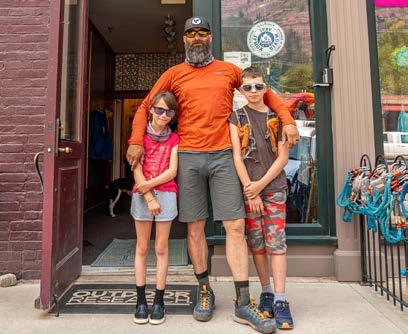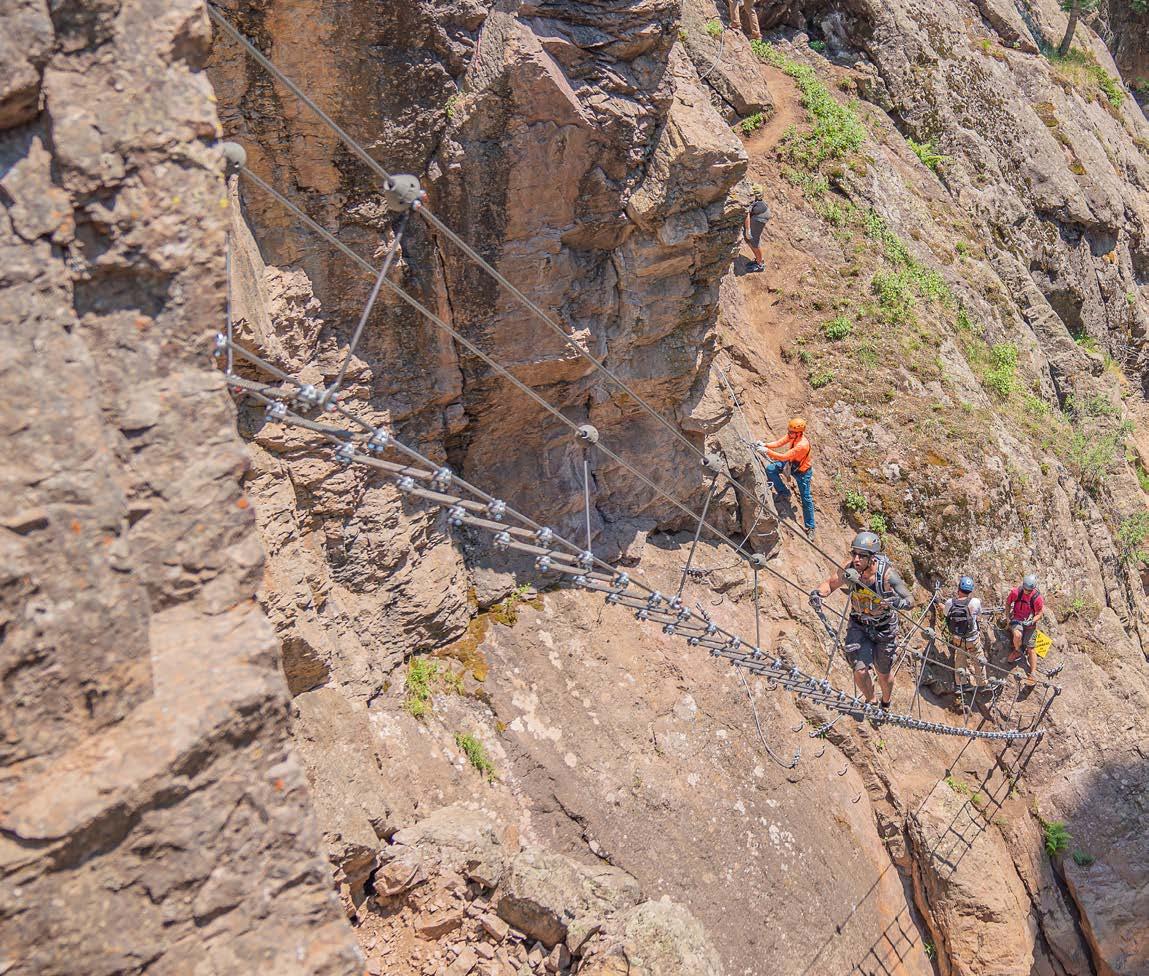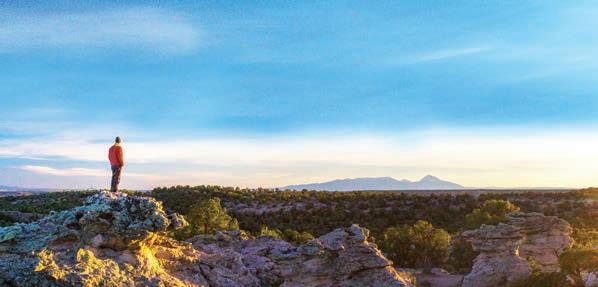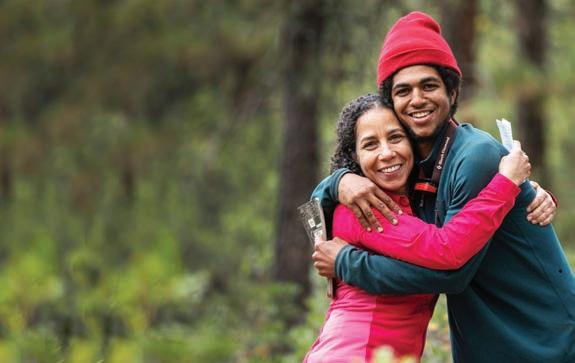
13 minute read
OURAY VIA FERRATA
Ouray’s New Via Ferrata Colorado is becoming a national nexus of vie ferrate
BY MORGAN TILTON
Advertisement
A plummeting cascade roars beneath me, and the cool breeze brushes my forearms as I traverse the Cable Bridge over the Uncompahgre River. I grip two suspended metal rails on either side of my head and inch my feet forward on the single steel cable beneath my approach shoes, like a high-wire acrobat on a tightrope.
Halfway across the 35-foot connector, I pause to look over my right shoulder and upstream at the Uncompahgre Gorge. The craggy, grey slopes steeply arch into the river like dorsal fins. The canyon’s cracks, ledges and terraces are decorated with shamrockcolored shrubs and stunted ponderosa pines. I consider the ancient backdrop of this cable bridge, which was installed less than 12 months ago: rust- and lime-toned quartzite that dates back 1.7 billion years. This raw, magnificent landscape makes me feel like an explorer entering an unmapped pocket in the peaks. I mindfully shuttle to the ravine’s east wall.
I’m climbing into the mouth of the country’s newest and most novel via ferrata on the southern edge of Ouray, in Colorado’s San Juan Mountains. Via ferrata is Italian for "iron path." A via ferrata involves climbing or hiking along an established route with metal holds and cables that are affixed to a vertical rock face. The anchored features range from rungs, steps and ladders to bridges, which allow recreationists to travel across otherwise impassable terrain. ››
Owner of San Juan Mountain Guides Nate Disser stands with his two kids Addison, 9, and Mason, 11, outside the Ouray Via Ferrata Information Center on Main Street in Ouray. photo by Eric Phillips

With the Uncompahgre River below, IFMGA Mountain Guide Nate Disser and Writer Morgan Tilton climb the vertical arrangement of rungs called Stairway to Heaven. photo by Eric Phillips

For safety, a climber wears protective, grippy gloves and footwear, as well as a climbing helmet, harness and via ferrata set: a certified lanyard system with two self-locking carabiners, which are clipped into the continuous cable system. Despite the fact that I haven’t rock climbed in nine months, I feel secure and at ease with this straightforward setup.
Ahead of me on the iron path is rockstar Nate Disser, an IFMGA (International Federation of Mountain Guides Association) Mountain Guide and owner of San Juan Mountain Guides (SJMG). He’s also the co-founder of Friends of the Ouray Via Ferrata (FOVF), the nonprofit that oversees the via ferrata.
“Remember to stay relaxed and extend your arms,” Disser reminds me and my partner, Eric Phillips, who is clipped into the cable behind me.
The three of us move like ants in a line beyond the Cable Bridge to an imposing sheer face with parallel hand and foot rungs. Here, the metal trail goes so close to the current that if a pebble dropped, I’d feel a splash against my calves. I focus on my hand and foot placement: This can be one of the trickiest segments of the entire route, Disser mentioned at the entry gate. I sidestep across the steep wall until a gully appears. We step off the aspect and

meander upward through a mix of stone and soil. Moments later, the towering facade that we crossed comes into full view behind us: Mars Wall, full of swirling shades of maroon, gold and daffodil. It reminds me of a Jackson Pollock painting. Below, the olive-hued water is transparent. Brilliant marmalade, crimson and honey rocks blanket the river bottom. This paradise quickly becomes one of my favorite vie ferrate, and for good reason.
The Ouray Via Ferrata is the most unique route in the country. It’s the first to be free to the public and reach the safety standards of both ASTM International and the European Committee for Standardization. By the time climbers reach the finish gate, they’ve ascended and descended 450 feet over a distance of one mile.
The one-way course starts on the south end of Uncompahgre Gorge. After an exciting kickstart on the Cable Bridge, climbers alternate between 4,000 feet of cables and 850 rungs as they explore the canyon. The path rollercoasters up-and-down, and snakes in-and-out of the mountainside’s organic formations. For a grand finale, climbers walk one-by-one up the first-ever via ferrata ascending ladder in North America, called Skyladder: a 75-foot long series of steps secured by four cables.
A handful of climbers wait in line to climb the Skyladder one-by-one. photo by Eric Phillips

“There are suspended, horizontal cable walkways in the U.S. but none that go up. There’s one in Austria. Engineers examined the terrain and approved this structure. We ordered the cables from Raumer Climbing, a manufacturer in Italy,” Disser says.
Vie ferrate were first created to aid the movement of troops through the Dolomites during World War I. Remnants of those original byways still exist in present day Austria and Italy. Postwar, the passages became recreational and evolved into tourist attractions. Over the past 90 years, more vie ferrate have popped up across European countries, North America and Southeast Asia, as well as Peru, Oman and Japan, to name a few. Today, close to 2,000 routes hang in Western Europe, and Italy boasts 400. In contrast, less than 20 commercial vie ferrate have been established in the United States.
“The National Forest Service and National Park Service do not allow via ferrata development on public land,” Disser says as we stand at the bottom of a perpendicular rung-ladder dubbed Stairway to Heaven, a zone that extends hundreds of feet above the loud stream below us. “There’s a much greater wilderness mindset here compared to Europe. And, there are not many vie ferrate in the U.S., so there are not that many installation companies.”
We each climb hand-over-hand and top out. At this high point the canyon expands. I catch a glimpse of snow-patched 12,800foot Abrams Mountain to the south, which makes me smile. I gaze around and try to identify the ravine’s subtle characteristics: I’ve climbed this iced over gorge in winter, but it looks like another planet. The opposing west wall hosts the Ouray Ice Park, which opened 23 years ago.
Ice climbing here has grown in popularity and strengthened the town’s economy. So, several local guides, including Disser, were inspired to create a complimentary warm-season activity in the gorge. The idea was first proposed by Clint Cook, the former owner of SJMG, 12 years ago. In 2016, Disser put fire to the concept alongside Cook — who became the lead installer — and Mark Iuppenlatz, who joined SJMG as co-owner in 2017. They sought approval from the City of Ouray, which owns the land, and launched FOVF, fundraising $250,000 for the project. The developers included local engineers Matt Hepp and Chris Haaland, who has built several vie ferrate including one at Jackson Hole Mountain Resort. Once drilling began, the via ferrata took five months to complete.
I’m 5-foot, 5-inches and none of the features feel too far apart for my reach. Like a ski resort run or rock climb, a via ferrata is ››
River Gorge. However, Colorado hosts more than half of the country’s vie ferrate including circuits in the Royal Gorge, Estes Park, Manitou Springs, Idaho Springs, Buena Vista, Telluride, Colorado Springs — at the Broadmoor Hotel — and now Ouray. Next summer, Arapahoe Basin Ski Area will debut one. And Disser plans to co-develop a hub in this box canyon with a second route on Ouray’s northwest wall, as well as a third on the town's periphery by 2022. “This via ferrata was my way to create abundance for this community,” Disser says. We trek past the emergency bailout and climb to a lookout. We take a seat on the bench in the shaded nook, beneath a giant ponderosa. As I gulp water, Disser talks about the benefits this via ferrata brings to the community. “The City of Ouray recognizes the via ferrata as an environmentally-friendly, human-powered activity for visitors and locals,” Disser says. “The attraction diffuses high-volume traffic from other locations to a new, non-developed area. It’s a gateway for people to experience climbing who’ve never done any climbing before. Plus, it’s satisfying that a lot of local climbers enjoy the Writer Morgan Tilton follows IFMGA Mountain Guide Nate Disser up the “Arrowhead” ascent on the Ouray Via Ferrata. photo by Eric Phillips route, too. And, the via ferrata installation does not interrupt other ice or rock climbing routes.” For this inaugural season, he anticipates that 8,000 venturers rated for difficulty. This one is 4B, according to the Fletcher/ Smith Italian Rating System: 1 to 5 indicates the technical challenge (5 being the hardest). And an A, B, or C indicates the level of commitment (C being the most serious). So, this via ferrata is a fair challenge due to duration — it takes up to 3 hours — moments of exposure, the elevation gain and loss and the overall commitment. There’s only one bailout trail once you start. So far, the route is fluid, interesting and fun to follow. “The overall craftsmanship and flow through the canyon really sets this via ferrata apart,” Disser says. “We wanted the route to feel adventurous and natural.” The three of us crawl, climb and ramble along the path back toward the canyon floor. We reach the base of a wide slanted ramp named Arrowhead. The long, protruding ledge reminds me of a triangle’s leg. I lean forward and pull on the rungs. The exposure here reminds me of an exciting via ferrata that I climbed at Kicking Horse Mountain Resort in British Columbia, Canada. Indeed, the via ferrata industry has been slow to evolve in the U.S., but the process recently became a bit more streamlined. In 2011, the Ski Area Recreational Opportunity Enhancement Act passed, which permits ski areas that operate on U.S. Forest Service land to develop recreational activities beyond skiing, such as vie ferrate. In turn, these installations have been fastened to rock walls at Squaw Valley Resort and will traverse the canyon from May to the end of October. Eventually, 14,000 climbers are expected to trace the gorge annually. In five years, the via ferrata is estimated to bring an additional $5 million in annual revenue to the local economy through new visitors and extended stays. “There will be annual inspections before being reopened, and we expect a 50-year lifespan before replacing certain elements,” he says. After our water break, we scale the rock above us to reach the trail’s high point, called Vista Point, which sits at 8,366 feet. To the northwest, Twin Peaks and Sister Peak stretch into the sky. As we descend, I get my first view of Skyladder. Disser points to the steep rock that extends well above the ladder. He explains that a new section of rungs will be drilled there this year: the Sky Climb, a 300-foot long advanced exit via the top of the canyon with few artificial holds and more natural rock holds. Climbers will need to choose between the Skyladder or the Sky Climb. Today, we drop into the gorge to climb the ladder. I wait for Disser to cross first and look around. We’re exceptionally close to the river. The powerful water resounds off the walls and rushes around gigantic boulders strewn with log debris. This experience is completely immersive and brings us close to an otherwise unapproachable arm of Mother Nature. I walk across the bridge and step off. To complete the Ouray Via Ferrata, certified safety gear is required and inspected by a FOVF member at the entry gate. FOVF plans to launch a Via Ferrata Festival with technical climbing clinics in Fall 2020. Learn more at ourayviaferrata.org. Mammoth Mountain Ski Area in California, as well as Jackson Hole Mountain Resort. Beyond ski resorts, adventurers can explore metal trails at Amangiri resort, on the Utah-Arizona border, Utah’s Waterfall Canyon, North Fork Valley, West Virginia and in Kentucky’s Red MORGAN TILTON is an award-winning travel and adventure writer for close to 60 publications. She lives in the Elk Mountains, where she scrambles and ropesup for rock ascents, ties into trail running shoes, clicks into skis or bike and clips into a snowboard or splitboard.

SPONSORED CONTENT
OPEN SKY
WILDERNESS THERAPY
Open Sky assists teens and young adults struggling with difficult challenges and life circumstances. Open Sky engages the transformational power of nature to strengthen relationships, foster growth, cultivate awareness, and develop overall health and wellness. Nestled in the mountains of southwest Colorado and the canyon country of southeast Utah, Open Sky’s approach transcends traditional wilderness therapy by emphasizing treatment for the whole family.
We sat down with Open Sky Field Guide Recruiter, Alex Bond, to find out more about working at Open Sky as a Field Guide: What drew you to wilderness therapy?
Before coming to Open Sky, I was a teacher. Although I enjoyed teaching, I was longing for more of the human connection side of the job. During my Field Guide training five years ago, it became clear to me that human connection was at the forefront of everything at Open Sky. I immediately knew this was where I belonged. I was also excited for the outdoors to become my classroom!

Why did you choose to come to Open Sky?
The decision to come to Open Sky was easy. My family grew up in Colorado and so I was extremely drawn to the beauty of the Durango area. I had traveled quite a bit prior to Open Sky, but there was always something about the four corners landscape that drew me back. While I came here for the natural world, the reason I’ve stayed is the amazing community and culture at Open Sky.
What qualities do you look for in an Field Guide?
We look for people who can take care of themselves in the woods (grit), along with the characteristics of compassion, tenderness, and empathy. We look for guides who have a variety of skills and experiences, a passion for teaching and being positive role-models for our students. Successful guides are able to persevere through adversity.
What motivates you to go to work every day?
That’s easy, the students. Our students are at an incredibly challenging place in their lives when they come to Open Sky. Many have never spent time in the wilderness and then suddenly, they’re living out there full-time. After a few weeks there’s a shift that occurs, in that they find a sense of courage in doing something they’ve never known before. It’s amazing to see.
What does the application and training process look like for new Field Guides?
The process begins with an hour-long interview. We have five pre-hire extended interviews throughout the year, each just under two weeks long, which provides a more hands-on, in-thefield window for the candidate and our team to decide if field guiding at Open Sky is a good fit.
What can a Field Guide hope to come out of this experience with?
One of the most rewarding things a Field Guide can expect is an incredible community that is honest and transparent with one another, offering coaching and mentorship each day. Not only does nature hold up a mirror reminding us of our strengths and challenges, our fellow Field Guides offer constructive and compassionate feedback. Having a job that allows you to figure out who you are and what you have to offer the world is such a gift.
READY FOR YOUR NEXT adventure?




OPEN SKY WILDERNESS THERAPYIS HIRING FIELD GUIDES!
INTERESTED? For more information, visit: www.openskywilderness.com/careers/










